

 |
 |
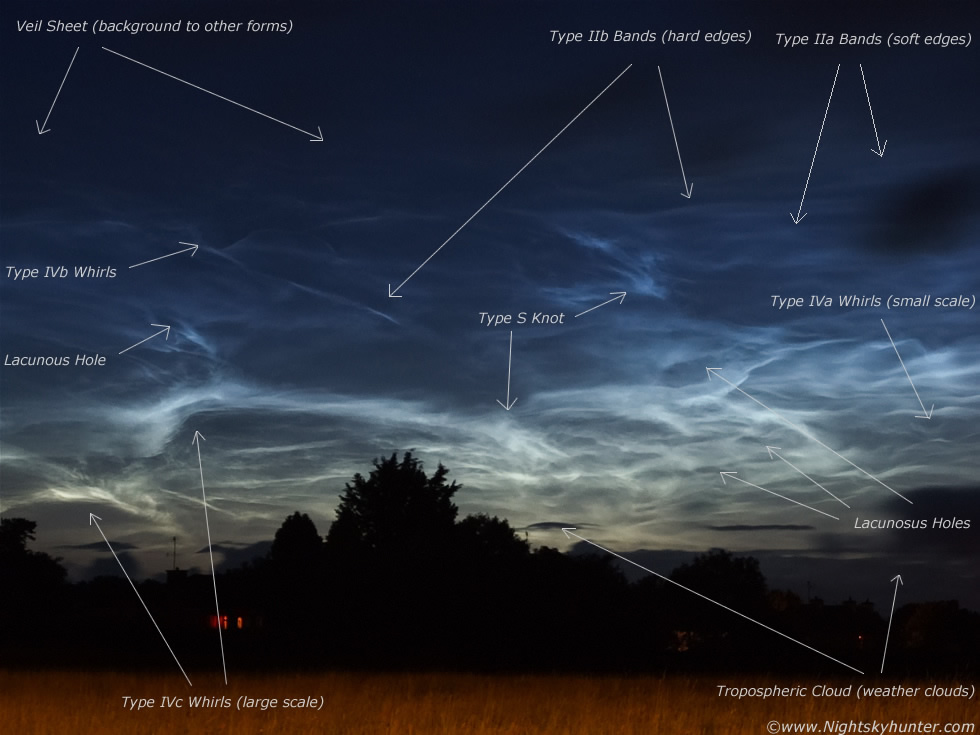 |
Visit the Nightskyhunter Noctilucent Cloud Gallery
For observers at mid-northern latitudes Summer nights remain bathed in bright twilight hampering most forms of astronomical observation. These mild Summer nights can be a joy for amateur observers however deep sky observing and even the aurora are washed out to insignificance due to 'nautical twilight' persisting all night long. However, all is not lost as Summer nights bring with them a different kind of phenomena. If you are located between latitudes 50 degrees and 65 degrees N or S of the Equator then you will be graced by the presence of 'Noctilucent Clouds' or NLC's for short. The NLC season typically runs from late May until early August in the northern hemisphere and from December to January for southern hemisphere observers, however sightings outside this latitude window have been recorded with ever greater frequency in recent years.
Since my own early sightings I have since been determined to observe every NLC display that appears each Summer period in the hope of gaining more proficiency with my observations and a better understanding of their appearance, frequency and movement by gaining as much experience as I can along with maintaining a dedicated photographic record of all displays which appear over N. Ireland.
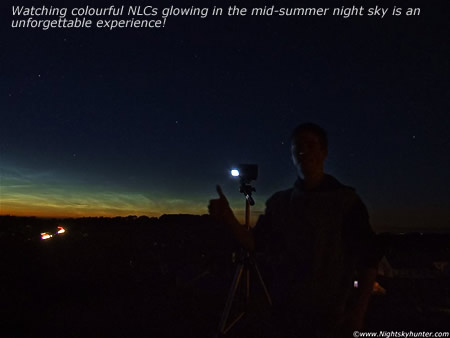 |
My own introduction to NLCs began many years ago when I accidentally encountered these eerie glowing clouds at the end of my Summer comet hunting sessions in the hours before dawn. I recall feeling mesmerized by the beautiful structure and colours they contained and knew deep down that this phenomena was something very special. At the time I did not realize what they were or their true importance, however in due course as my curiosity heightened I gradually began researching through various books and magazines to get some understanding of what was going on and how to go about observing them. I was fortunate enough at the time to befriend a veteran NLC observer with over 30 years of NLC observation under his belt at my local astronomical society who has since developed my interest in NLCs to a high level. His name is John C. McConnell and in the years to come we would be swapping countless text messages and phone calls discussing these amazing clouds. |
The Summer of 2005 and in particular 2006 and 2009 produced the best displays I have ever seen. I never realized that nature could produce such beautiful art work in the sky. Each display was unique and the best of them covered much of the entire night sky with breathtaking colours, these were unforgettable sights. If you have never seen a bright complex Noctilucent cloud display before then be prepared to be amazed. These clouds promise you a profound visual experience and once you have seen a good one then the chances are that you will be hooked for the rest of your life just as I have. Warning - be prepared to miss out on alot of sleep!
NLCs bare little resemblance to normal clouds which form in the Troposphere - a region of the Earth's atmosphere located 14 km (9 miles) high, this low altitude results in our weather clouds appearing dark against the Summer twilight sky as they reside in the Earth's shadow hidden from the Sun's glare. Noctilucent is a Latin derivative which loosely translates as 'Night Shinning' and shine they do. The term 'Noctilucent Clouds' (Leuchtende Nachtwolken) was probably first coined by O. Jesse who was then active at the Berlin Observatory making the first photographic measurements of clouds. When the Sun is between 6 degrees and 16 degrees below the horizon the NLCs, which are located at a height of 82km in the Mesosphere, are illuminated by sunlight where they then become visible to ground based observers.
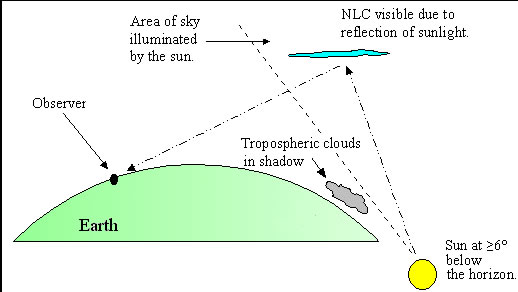 |
Very little is known about NLCs even today, in fact the details of modern NLC science could be presented on the back of a post card. These clouds are mysterious in the extreme and observations and images are sought after by researchers making this field of astronomy and meteorology one of the few areas were amateur observers can contribute to science. The genesis of the Noctilucent clouds are as elusive as the clouds themselves and theoretical at best however a popular and plausible belief among researchers suggests that NLCs are made up of meteoritic dust particles encased in ice crystals. These ice crystals which contain dust particles from meteoroids, comets, and asteroids are so small their size is likened to the particles in cigarette smoke. |
NLC ice crystals are so transparent that they only reflect 1 in 1000th of the incident sunlight they receive hence why their tenuous profile is never seen in the day time sky. NLCs are very thin, measurements have suggested their optical thickness is in the region of 10-4nm with cloud particles in the range of 50nm. The Mesosphere where the NLC particles reside experiences a freezing temperature of -100 degrees celsius, here there's very little water however at this temperature any molecules of water which do form will rapidly turn to ice and encase any dust (meteoritic) particles - which act as a seed - were the process of nucleation induces the NLCs to drop by several kilometers to the altitude in which they are normally seen some 80-100km above sea level.
The coldest temperatures in the Mesosphere form over the Earth's polar regions during the Summer months which explains why NLCs are only seen at this time of year. You can use this link to check the latest Mesosphere temps over the UK which is a very useful tool. Some researchers suggest that the presence of NLCs are an indicator of global warming, the reasoning being that increased methane and warmer temperatures at lower altitudes results in decreased temperatures in the Mesosphere inducing the process of nucleation and hence NLC formation. Much further information using modern ground based observations, historical observations and science gathered from the new AIM satellite launched in 2006 will shade new light into NLC formation. For now NLCs remain as exciting and mysterious as they have always been.
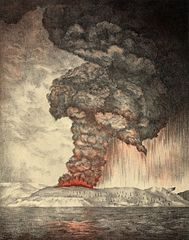 |
It is well known that the first observation of NLCs was made by Thomas W. Backhouse in 1885 fully two years after the violent 1883 eruption of the Volcano on Krakatoa Island - a tsunami generating event - which completely destroyed the Island itself and sent immense concentrations of volcanic ash into the upper atmosphere which was thought by many to be the progenitor event that led to the formation of NLC's which began to manifest with more frequency after the event. However more recent studies suggest the event was not responsible for their formation at all. Garsden and Schroder (1989) debated on why there were no sightings of NLC prior to 1885 and suggested that the eruption was significant because it alerted observers to make careful studies of the Summer twilight sky. It's certainly a good theory however one must find it difficult to accept that no one watched the twilight sky at all predating the eruption. < An 1888 lithograph of the 1883 eruption of Krakatoa from Wikipedia |
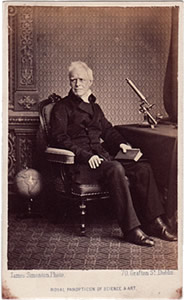 |
As it turns out there is at least one possible NLC sighting that predates the Krakatoa event by some 35 years. Dr Christopher John Butler research astronomer at Armagh Observatory in N. Ireland who is passionate in the field of historical meteorological and atmospheric phenomena highlights observations recorded in the observatory's meteorological records by Thomas Romney Robinson who was the third director of the observatory at the time. Robinson made a series of interesting observations between 1849 and 1852, however two of his entries in May 1850 may describe Noctilucent clouds. On the 1st of May he notes ''strange luminous clouds in NW, not auroral'. This does sound very much like NLCs even though early May falls outside the typical NLC 'window' however it is still possible as NLCs can form at Armagh's latitude within this period. An early observer of NLCs, Robert Leslie, gives a striking account of these clouds describing them as ''weird small cloud forms, at times very regular, like ripple marks in sand, or the bones of some great fish or saurian embedded on a slab of stone'' (Ken Kennedy 2006). A marvelous description indeed which I'm sure gave birth to the 'herring bone' classification structure in modern times. |
Visual observations of NLCs are fairly straight forward however you will need to remark on a number of key factors to make your observations worth while for data collection. Visual observers should record the altitude of a display along with its azimuth accompanied by brightness values and records of structure over a period of time during the apparition. An NLC session should include all of the following.
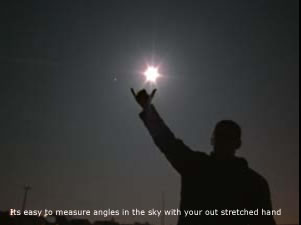 |
Measure the full angular extent of the display in degrees. N = 000 degrees E = 90 degrees S = 180 degrees W = 270 degrees. The magnitude +2.0 naked eye star 'Polaris' defines your northern point above the horizon. Example: you see an NLC display extending from the W to 10 degrees W of N, your azimuth will be 270 degrees - 010 degrees. It can also help to measure the full length of the display using the hand method. Hold out your hand at arms length, spread your fingers, and try this simple technique. |
1) The distance between your little finger and thumb = 20 degrees (40 full moon diameters)
2) The distance between your little finger and first finger = 15 degrees (30 full moon diameters)
3) Your full fist = 10 degrees (20 full moon diameters)
4) Three finger tips = 5 degrees (10 full moon diameters)
5) Your thumb = 2 degrees (4 full moon diameters)
6) Little finger tip = 1 degree (2 full moon diameters)
Measure the angular height of the NLC display using the hand method and if it is clear to see measure the height of the base above the horizon although this will not always be possible as the base can merge with horizon murk or clouds.
The brightness of a particular NLC display can be estimated using the official 5 point scale detailed below. New observers might find it difficult to allocate a brightness value however with practice it will become second nature. I have used a selection of my own images to help demonstrate, however it should be noted that real NLCs can be fainter or brighter than what is shown here so these are simply a representative example of each class. With practice you can break the rules and give a more precise estimate for your own records. For example instead of estimating Type 3 you can refine the estimate to Type 3.5.
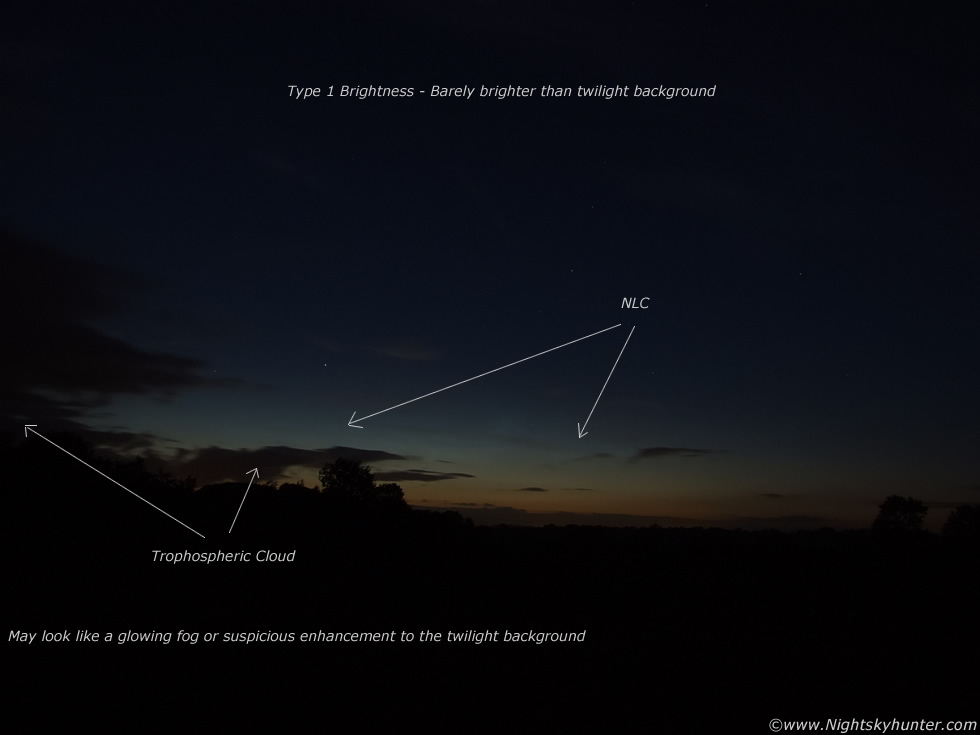 |
Very dim NLC present, barely brighter than the twilight background, may have the appearance of a faintly glowing white mist or fog. The fainter Type 1 displays may require averted vision and are mostly missed by inexperienced observers. If you are not certain then use a pair of binoculars or take a short exposure with your camera, make sure the Sun is between 6 and 16 degrees below the horizon using planetarium software or get confirmation from other observers.
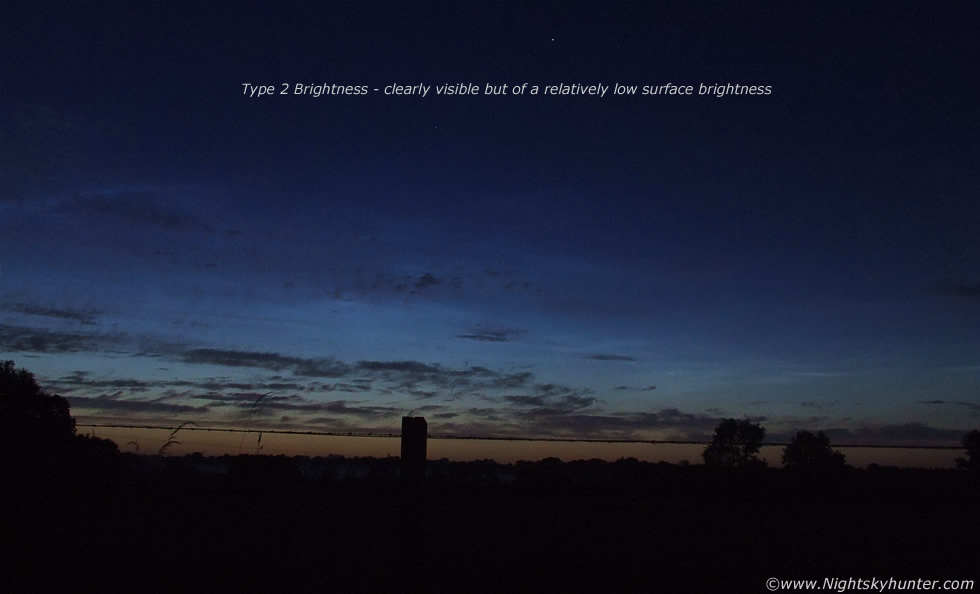 |
Clearly visible against the background twilight but still with a relatively low surface brightness. Type 2 NLCs can manifest as a distinct blue glow against the sky as a pre-cursor to increased structure development.
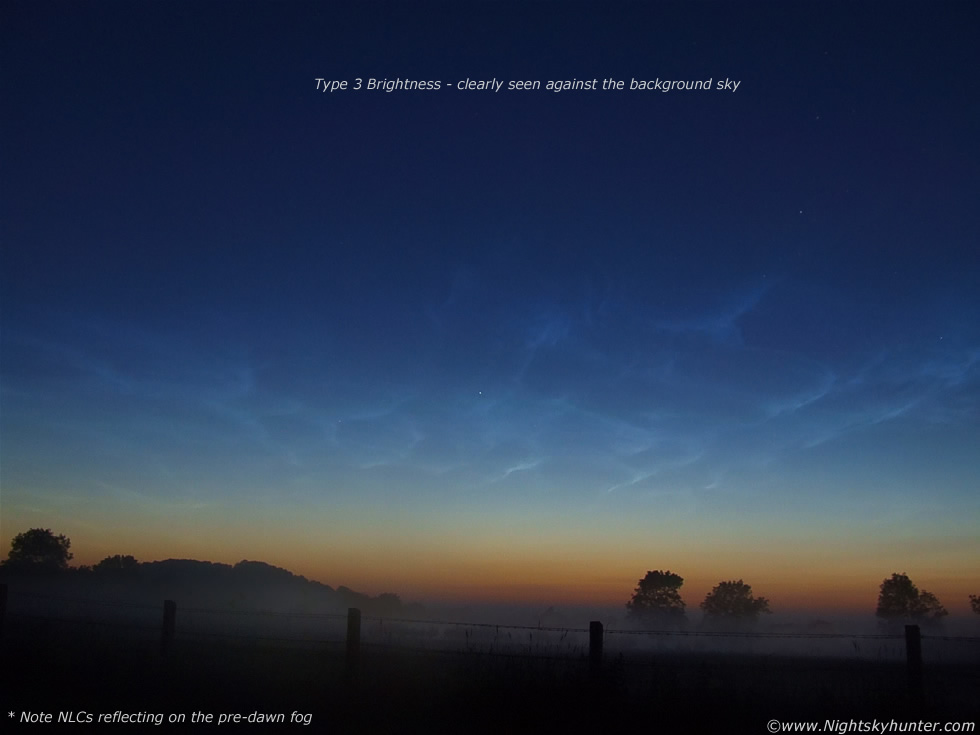 |
This brightness level indicates a quite obvious display standing out clearly against the background twilight, they are unmistakable.
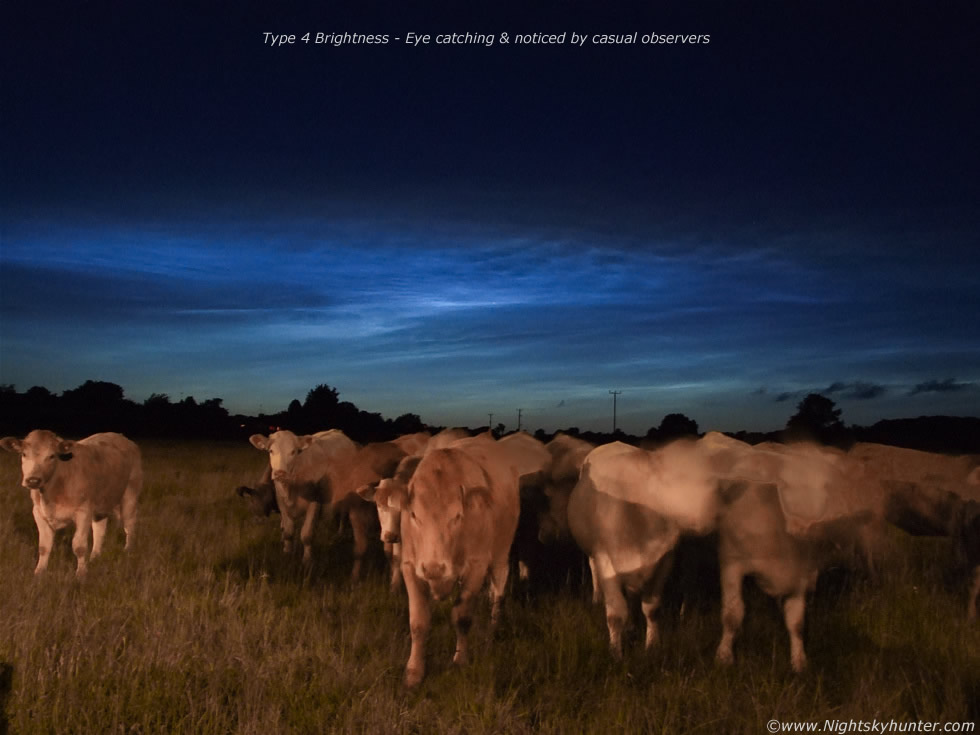 |
Bright NLC display, eye catching, very easy to see and would be noticed by casual observers. Type 4 brightness is almost always associated with a spectacular display and can cast shadows on ground objects, some people have even mistaken them for a bright aurora display.
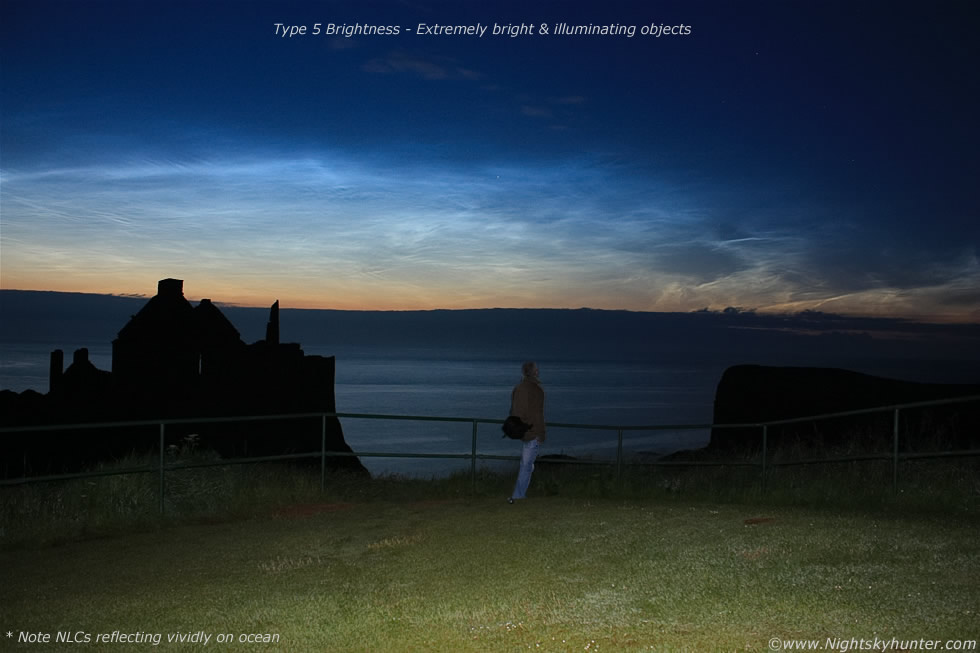 |
Extremely bright and can illuminate buildings facing the clouds. Often type 5 NLCs can wash out bright stars such as Capella by several magnitudes and in extreme cases compete with the brilliance of planets Jupiter and Venus. These will impair your dark adaption and would be seen by many with ease. I have observed Type 5 displays making fog glow bright blue, reflecting vividly on passing trophospheric cloud, and bathing fields in their eerie light. In the past observers could read a newspaper by their great luminosity. A type 5 NLC display is the holy grail of the NLC observer and simply unforgettable!
Each NLC display is composed with various forms of structure of which there are four main groups, Veil (Type I ), Bands (Type II ), Waves or Billows (Type III ) and Whirls (Type IV ). Several classes are even further subdivided into other specific classes. Occasionally NLCs will possess a structure that does not fit into the four main groups so another four point 'unknown category' exists, see the image examples below for all the major classes. An NLC display may consist of only one class or many of the classes at the same time. With a little practice you will become proficient with matching an NLC display with its appropriate classification Type.
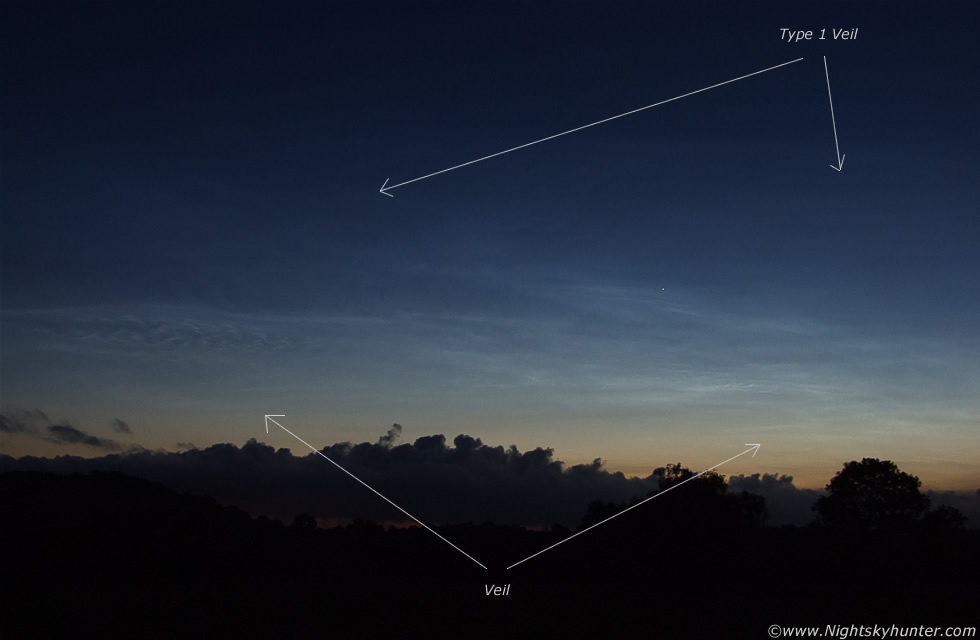 |
Veil type NLC apparitions have no structure taking the appearance of a sheet, fog, or mist, and sometimes seen as a background to other forms. Seen on its own in the dead of night the veil can look ghostly. Brightness type 3-5 Veils are easy however Type 1-2 are often confused with the Summer twilight glow by inexperienced observers, watch out for moonlight and the twilight sky itself reflecting on high level cirrus clouds. Can you tell the difference?
These are streaks or lines which may be parallel, meet and/or cross at small angles. They are further subdivided into two more categories.
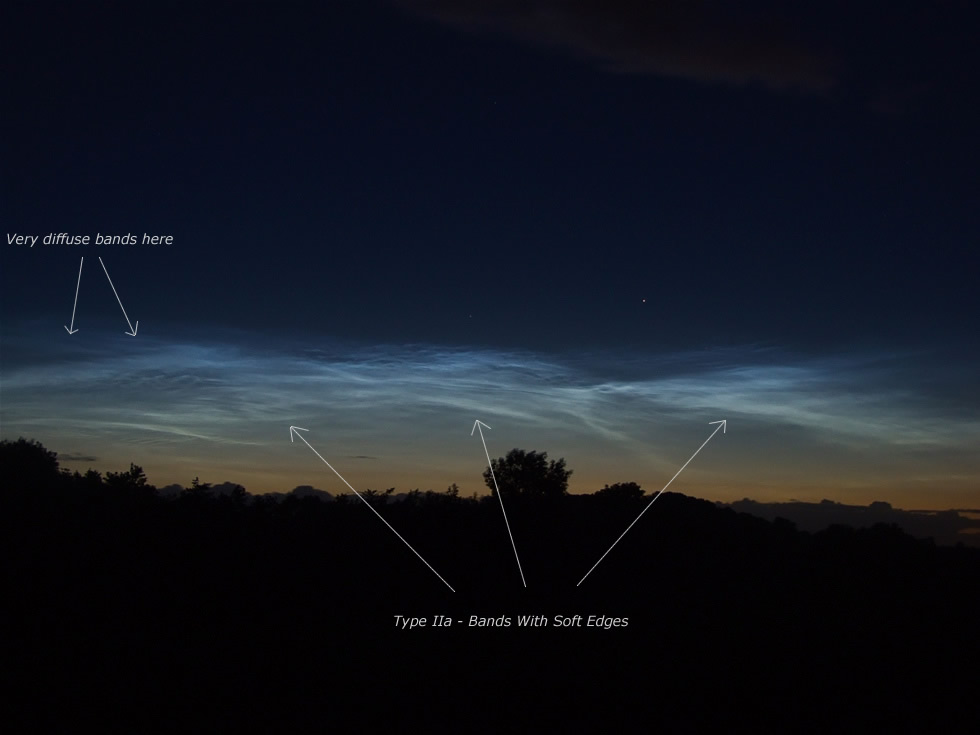 |
Bands with blurred, soft, or diffuse edges similar to the diffuse edge of a comet's coma where it may be difficult to tell where the band ends and the sky begins, this is a kind of gradual fading.
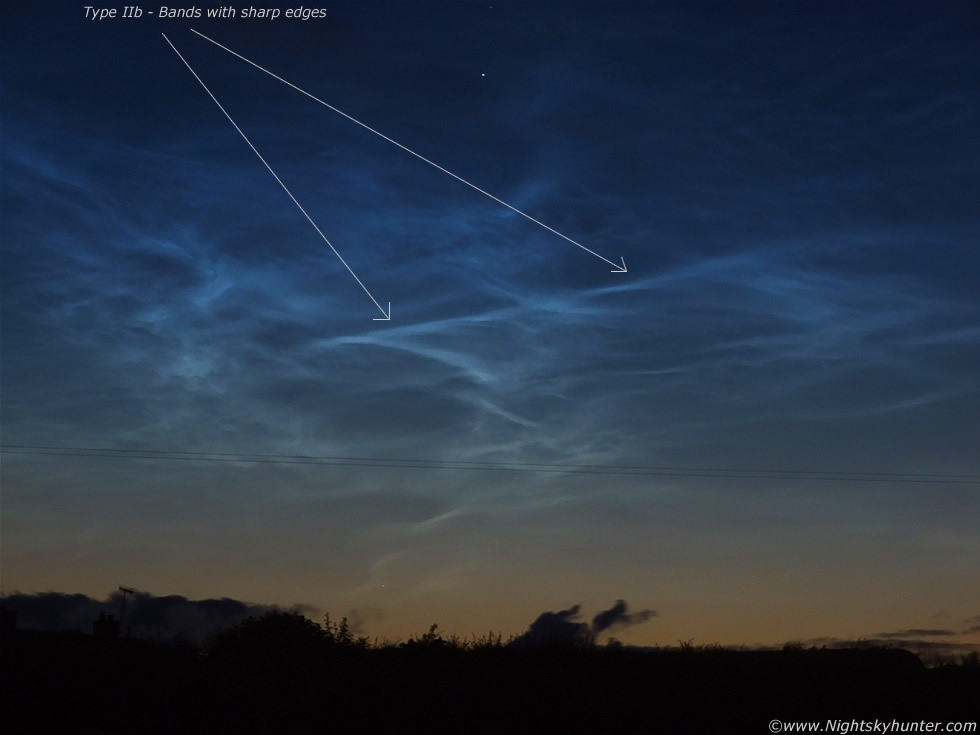 |
Bands or streaks with sharp well defined edges which can be either isolated or clustered in groups. Type IIb bands look very spectacular and most striking when a shadow from a band/s can be seen cast onto another background NLC form which generates a very 3-D like effect.
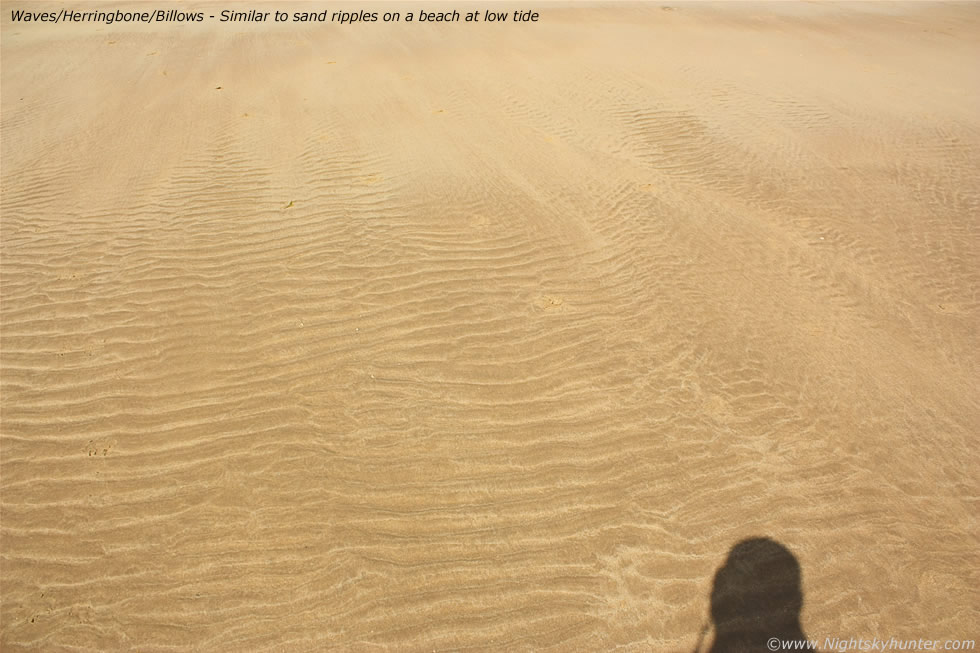 |
Waves are the definitive NLC structure, also known as Billows or Herringbone. These look like sand ripples on a beach at low tide - see Robert Leslie's description above - and are often seen in conjunction with type IIa and IIb bands. Waves are further subdivided into two category's of Type IIIa and IIIb described below. The above image was taken at Benone Strand in N. Ireland during a glorious hot day while waiting for the first displays of the 2012 season. The NLC-like wave structure in the sand can be seen which makes for a great comparison.
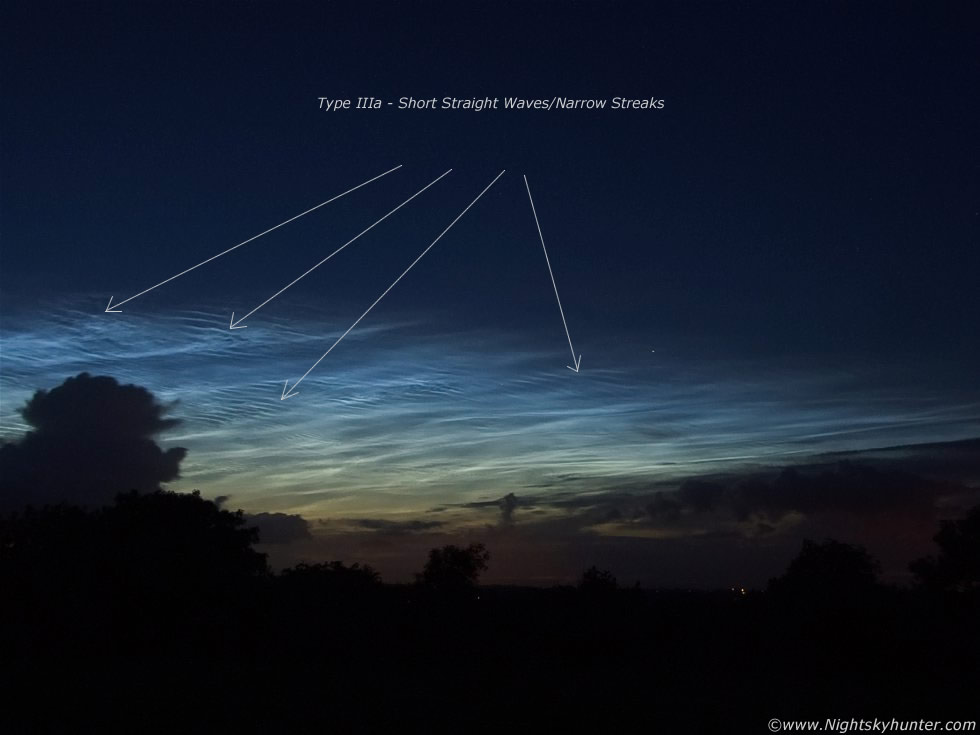 |
Type IIIa waves take the form of short, straight, and narrow streaks. This image taken during the active 2009 season shows these forms extremely well, you will see these waves more often than any other NLC structure.
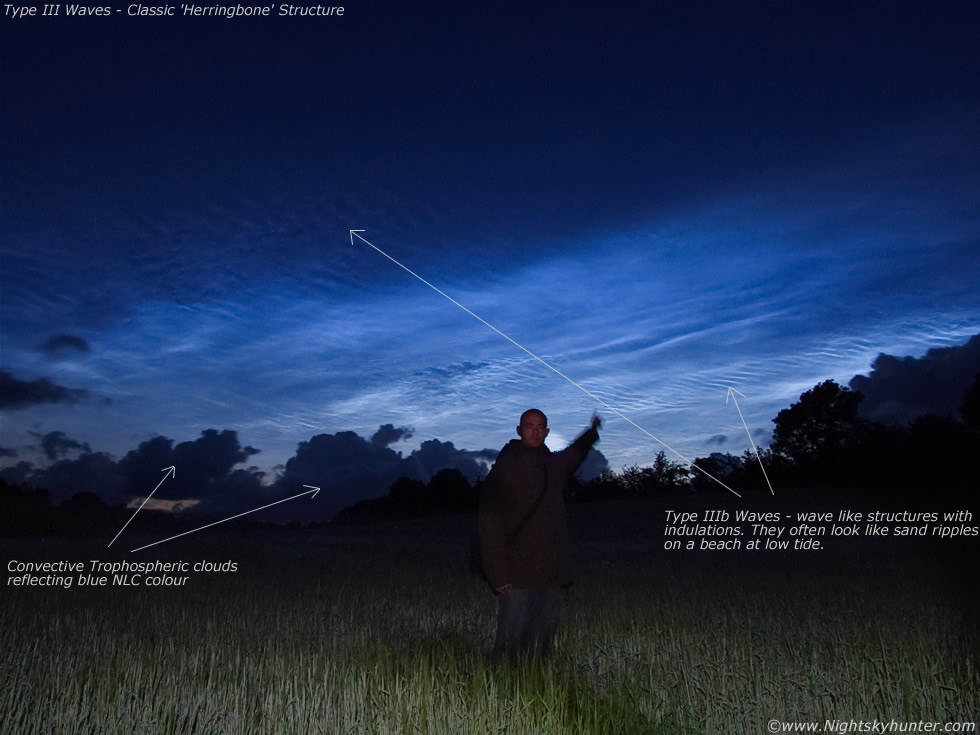 |
Same as the previous type however this time the Billows may sport a wave-like structure with undulations, the extent of these undulations can vary greatly. The above image was taken in 2009 during an incredible all-sky display which appeared after sunset with a great array of Type IIIb waves on show.
Whirls consist of looped or twisted structures and are subdivided into three categories by radius of the whirl.
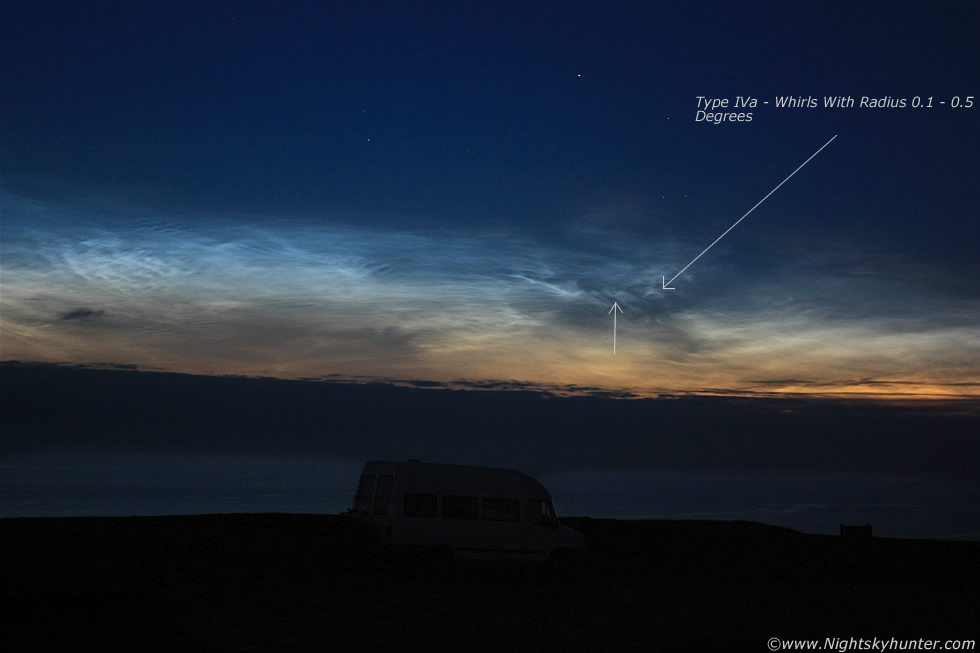 |
Type IVa - Whirls with small angular radius (0.1 - 0.5 degrees) so these are small scale structures no larger than the apparent size of the full moon (1/2 a degree) however keep in mind that in reality these structures are located at a vast height over 50 miles high so in reality they would be very large indeed!. This image was taken during the 2011 season late in the night looking across the Atlantic Ocean in Co. Antrim towards Scotland.
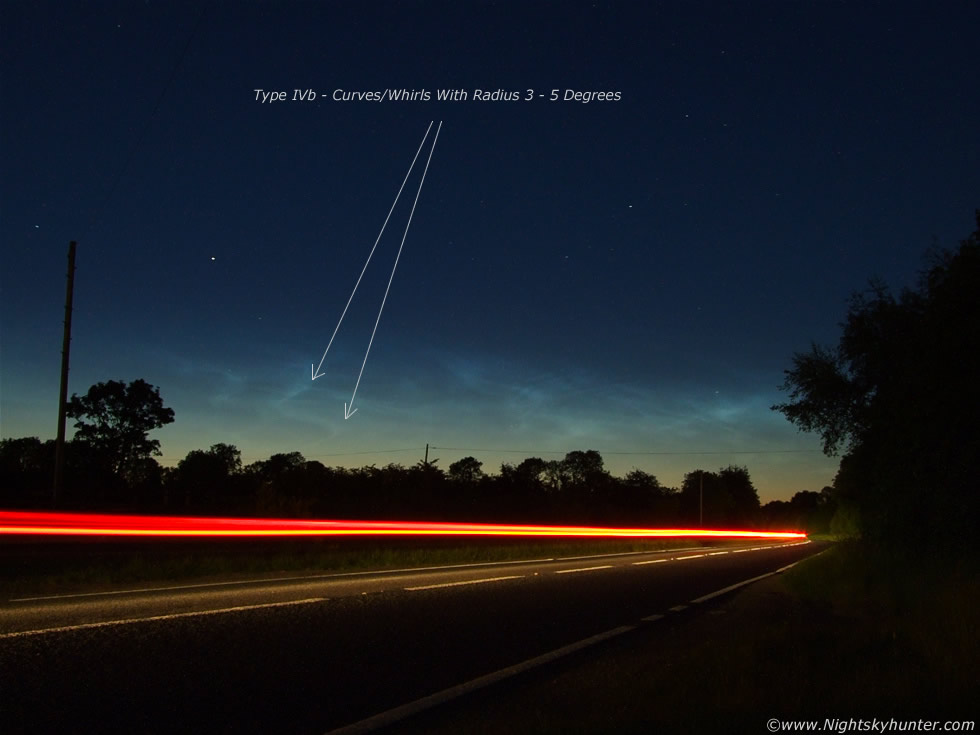 |
Simple curves with angular radius between 3 - 5 degrees (6 - 10 full moon diameters). This was one of the first complex displays of the 2009 season which had well formed IVb Whirls below Capella.
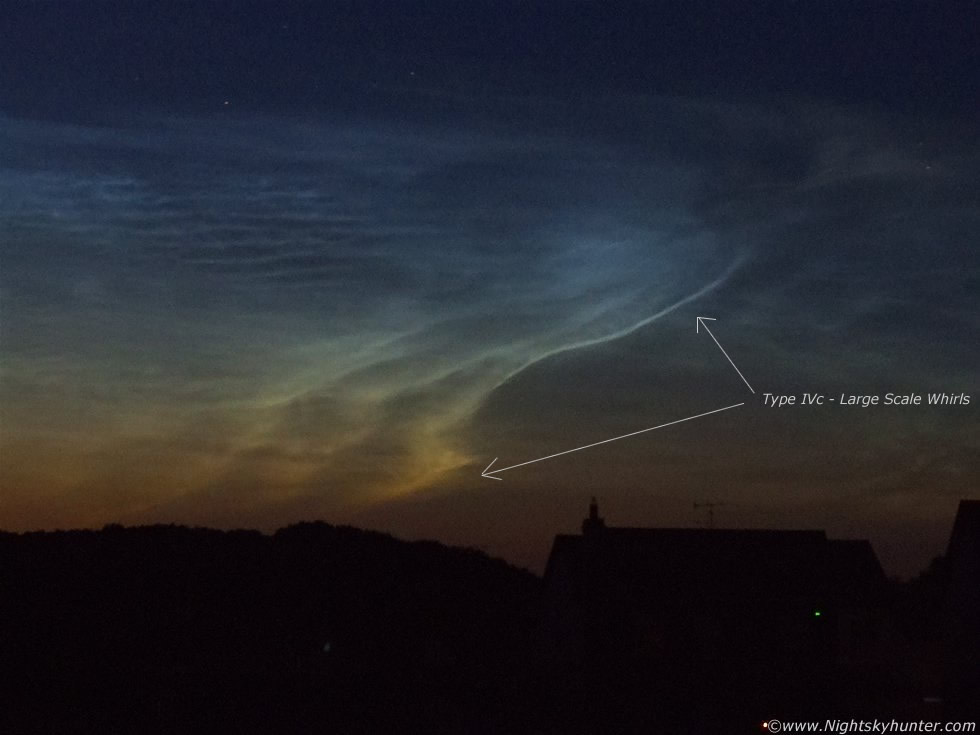 |
Large scale Whirls with an angular extent of 10 degrees (20 full moon diameters) or more. These are my personal favourite NLC structure due to their dramatic nature, if you look carefully you should see these Whirls moving against the background stars which can be spectacular to watch. Whirls are most often seen in very complex displays and can share the sky with a network of Waves, Bands, and other structures which when merged together can form very eerie forms which can look Alien or even skeletal in nature. On occasion I have observed glowing spines, reptiles, and even a ghostly humanoid form in a running pose.
The complex structure falls into four main categories.
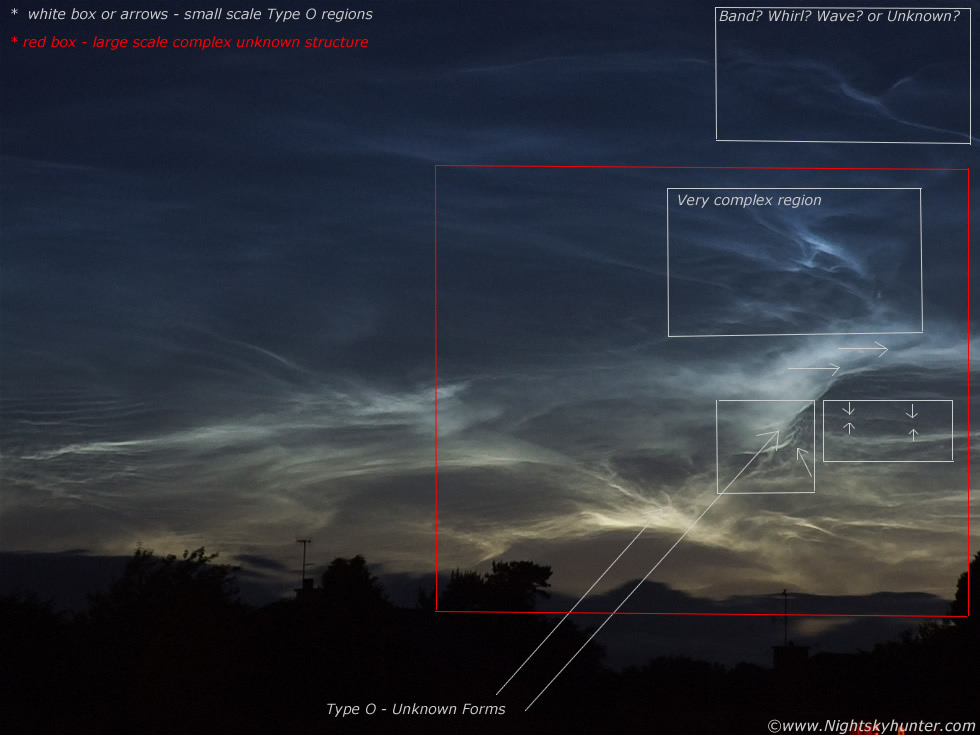 |
NLCs which do not fit into types I - IV. This is the unknown category however it should be noted that true unknown structures are probably few and far between. It is most likely that any Type O structure will be a combination of Bands, Waves, Whirls, Knots and Nets in unison. The above image was taken on June 18th/19th 2009 and shows the most spectacular NLC display I have ever seen so far, this was during the peak of the lowest solar minimum for a century and from my visual records at the time I am quite certain this contained unknown structure, some of which I have highlighted above where several structures converge. The image at the top of this article was also from this very same night.
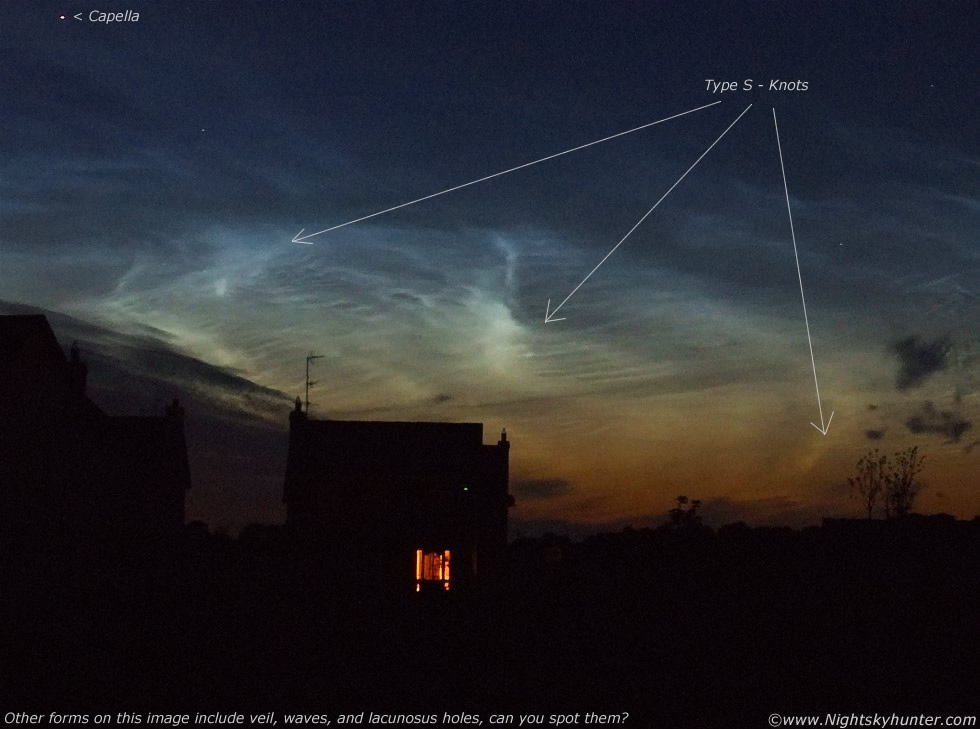 |
Bright Knots or obvious enhancements to any NLC display are normally classified as Type S. This excellent example was captured during the 2006 season which was my first year of very complex NLC displays and since then I have never looked back. This was taken back in the days before streetlights where introduced to my area so I was able to photograph this display literally from my own home, I used an old bridge camera, my trusty Fujifilm S5600 which is proof that you don't need expensive camera gear to record NLCs, in fact, during the 2005 season I even used a point and shoot camera on night mode which did just as well and modern day mobile phone cameras should do them justice too, especially the brighter displays, why not give it a go?
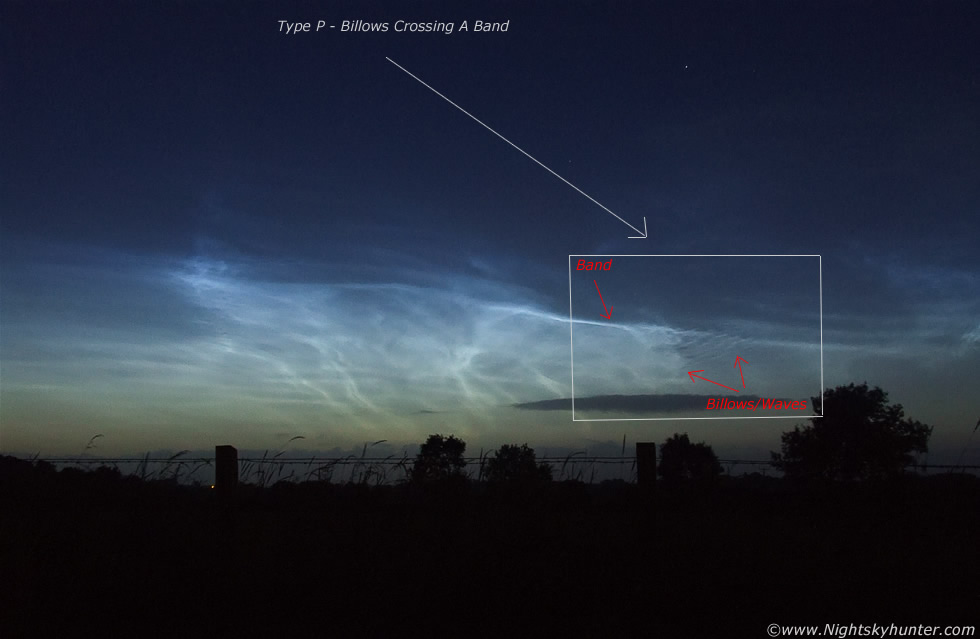 |
This was either 2007 or 2008, that night began cloudy so I waited for a period indoors watching a DVD when I suddenly got a text alert from prolific NLC observer John C. McConnell about a bright NLC display visible. I grabbed my gear and ran outside and it had suddenly cleared so I got to the bottom of the road to record this beautiful pre-dawn show. Visually the scene reminded me of two silver Stallions galloping side by side through the sky from R to L , you can see the legs below and the long flowing tail behind. When I look at it now that tail looks more reptilian in nature like the tail bones of Velociraptor. The boxed region is a good example of Billows crossing a very long band. Remember that Billows are just another name for Herringbone or Wave structures so don't get confused.
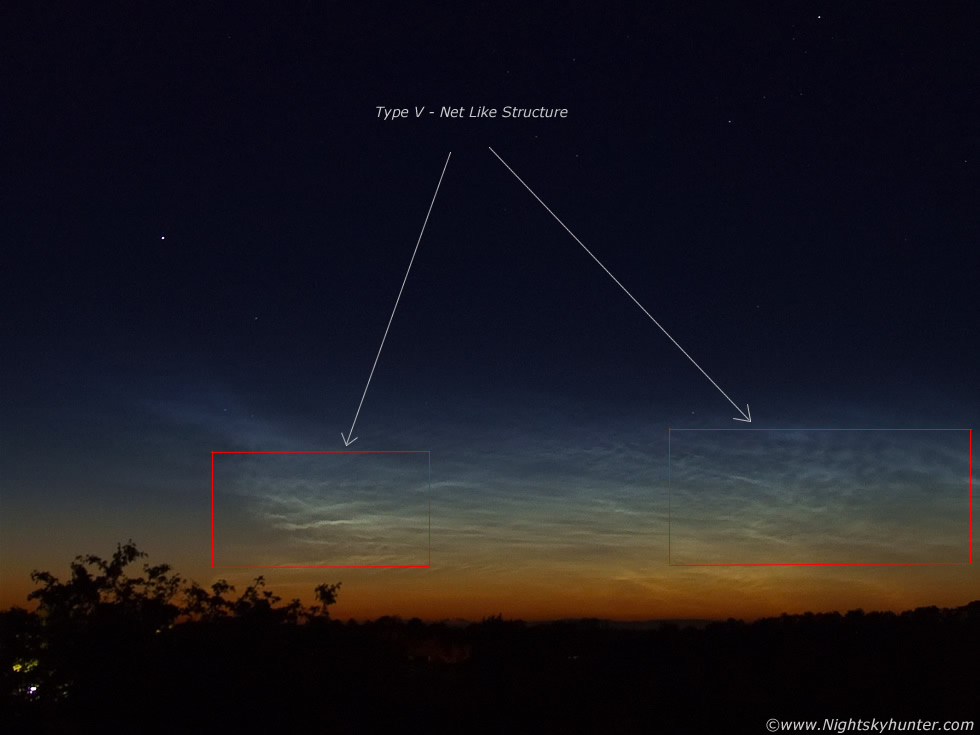 |
Net-like structure, similar to a chessboard. These are most likely the product of two or more layers of NLC overlapping creating a pattern similar to a fishing net. In my opinion Type V ranks among the finest examples of NLC structure possible with the gaps in the celestial 'net' appearing as either elongated ovals, fine squares, or in rare cases a stunning network of diamonds. The above example was taken during an all-night display from 2006. Type V structures are most likely to be seen when NLCs are low in the sky, when this happens you are viewing the clouds side-on at an oblique angle so combinations of cloud have a greater chance of criss crossing one another as opposed to the vast zenith-crossing displays which look more like single sheets and hence less likely to show complex forms.
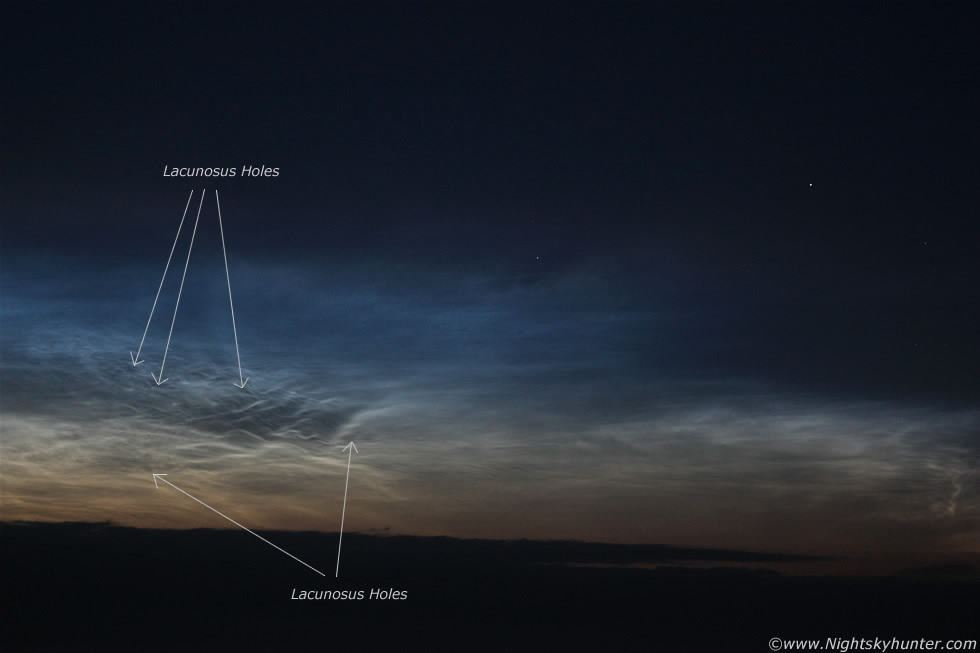 |
Lucunosus is Latin for 'Full Of Hollows', these Lacunosus Holes or Pits are most often seen in mid level and high level weather clouds such as Cirrus, Cirrocumulus and Altocumulus however the most spectacular examples can be found within Noctilucent Clouds. Lacunosus Holes are fairly common but no less spectacular for it with a wide range of specimens possible to observe ranging from perfect little holes to elongated pits to large bubbles or sharp well defined hoops which at times can resemble honeycomb structure. These Holes are often dramatic, arranged in clusters, and on occasion can look similar to the craters on the moon with their 'floors' bathed in dark shadow. The above image from 2011 was a fine display however it wasn't the best example of these Holes, despite this you can see that a sector of the display contains a selection of small Lacunosus Holes which have been stretched by the motion of the Wave structure during the exposure.
This concludes the main classification system for NLCs and no doubt it will be revised in years to come so thanks for reading and I hope it helps you understand these structures in a simple easy to understand way. The best thing to do is revise these various forms and scan through the internet and practice naming the structures you see using other NLC images (or check out my own galleries) until you can identify these types at a casual glance, once you see your very own NLC display your structure classification ability will be second nature, and with a little experience, second to none!
In the rare chance that an aurora display coincides with an NLC display then this must be noted. Record colour, brightness, altitude and azimuth of any aurora present including its form and position in relation to the NLC display or simply take one or two photographs.
As with all kinds of astronomical observations one must keep note of the sky conditions. Record the presence of moonlight, murk, mist, fog, transparency, seeing, and the presence of any Tropospheric clouds.
If you do not own a camera then why not try making a simple sketch of the NLC forms at 15 min intervals. Note the various NLC forms, height, azimuth, and any comments on colour and movement. Four sketches during a 60 min period can show the NLCs development or decline very well. Record all your observations using Universal Time (U.T) or local time zone.
NLCs can appear in the sky at any time during the night, they can manifest after sunset, at midnight, or before dawn so keep vigilant. A regular check of the northern sky every night, and many times during a night, is essential if you want to spot NLC activity. It is estimated that for a given NLC window period combined with average weather conditions a single observer may see more than 12 NLC displays during a season although this will largely depend on the frequency of clear nights from a given location. Do keep in mind one thing - premature retirement - this happens when a bright NLC display appears after sunset, particularly in late July and early August when NLCs will appear to fade and drop in height as the night draws in. To many it would seem that the show is over for the night however this is only the Sun dropping lower than 16 degrees below the horizon. Very often in the hours before dawn the NLCs will return as the Sun begins to climb again which can reveal a display that borders on breathtaking which will be missed so do keep this in mind. The chances are that if you see an impressive display during the evening then it should return again before dawn.
High level Cirrus cloud can easily be mistaken for NLC especially just after sunset when the low level Sun illuminates these delicate cloud strips with a golden or red colour. Watch these carefully as Cirrus will betray their identity by their 'normal' movement and darker profile as the Sun drops lower. NLCs tend to appear in the region of sky above the Sun however formation to the E and W of the sunset point is not uncommon.
Use a pair of 7X50mm or 10X50mm binoculars to scan the twilight sky after sunset. This method can detect NLCs that would be too faint for the naked eye. NLCs differ from Tropospheric cloud as they can bare magnification. Non NLCs will have soft edges with a low contrast dark profile. Real NLCs are unmistakable.
When a large extensive NLC display is present you will often be startled by the sudden movement of these creepy glowing clouds. Keep your eye on the bright star Capella in the N and watch the movement of the NLCs as they drift by this star. This movement is often shocking and is even more impressive in binoculars. NLCs have two kinds of motion...
1) Watching carefully (facing N) you will notice the NLC formation drifting to the E (left) in real time, this effect is due to the rotation of the Earth, keep in mind that NLCs move at 400mph which is as fast as Jumbo Jet!
2) NLCs will appear to either drop in height or grow in height. The mechanism responsible for this is the Sun which lurks close-by under the horizon. NLC altitude will drop with a lowering Sun after dusk and rise with the climbing Sun before dawn.
Taking several images separated by 5-10 min's will show this movement easily. Often the Waves or Bands of a Type 5 display will occult Capella as they pass causing the star to fade and brighten like a cataclysmic variable star. NLCs brighter than planet Venus (Mag - 5.0) are not uncommon in which case they will block out any star in that region of sky.
One of the most striking visual aspects of the NLCs are their colour which is mostly due to the position of the Sun below the horizon producing atmospheric effects. At the horizon, which often merges with the base of NLCs, one can see red, orange, yellow, green and golden colours. Moving higher into the main body of the display the NLCs typically sport stunning white or silver colours. The top of the display may well have a striking electric blue or purple canopy. This general blue colouring is caused by absorption of incident sunlight by ozone in the Chappius Bands which reside in the yellow portion of the spectra (Gadsen and Parviainen. 1995). These colours combined together can make for a beautiful art work against a canvas of stars. A short exposure with a camera will capture these very well however be careful of overexposure which will reveal an unnatural 'white' image. An underexposed image will capture the colours more accurately, after all you want to record this phenomena as accurately as can.
The use of a polarizing filter for visual and photographic observations can produce successful results. These filter out certain rays of light and select others giving a view or image with increased colour saturation and contrast. They come in two main types PL (Linear Polarizing) and PL-CIR (Circular Polarizing). The PL-CIR is recommended unless you have a manual focus camera with no beam splitter. These filters can be purchased from any good camera retailer.
NLCs are a beautiful photogenic subject and images taken of bright displays are not only satisfying but are of use to researchers. Getting an image of NLCs is easy however getting a GOOD image may be a little more difficult. Good images of very bright displays can be captured using an ordinary off-the-shelf digital camera. Attach the camera to a tripod, switch your camera to night mode which will take an exposure from 1 - 3 sec's, select your highest ISO setting and set your focus to infinity using the 'mountain or landscape scene' function. Set the timer between 2-10 sec's to reduce vibration and take your shot. Type 4 and 5 displays will be easily captured however the fainter types will be rather more difficult and will involve simple post-image processing techniques (contrast increase, brightness increase) to 'tidy' the image into an acceptable result. If you do not have access to a tripod then improvise using a window sill, fence post, or car rooftop - be creative.
With more expensive 'bridge cameras' or top of the range DSLRs the process is a little different. An ISO setting between 400 and 1600 combined with an exposure between 2 - 15 sec's, wide aperture, and of course timer/remote shutter/cable release and tripod to reduce vibrations. You can achieve delightful results if your camera has a high optical zoom function (5-10X) or you own a telephoto lens. Zoom in close to your target area and manually focus your camera using a bright star before hand like Capella, Arcturus, or a bright planet and take your exposure. Some caution is required here as the NLCs may trail along with the stars so dropping the exposure down will produce more pleasing results. These settings are meant to be a rough guideline as the NLCs themselves or the sensitivity of your camera may need very different settings. The general idea is to capture the NLC display clearly without overexposing the clouds themselves or the sky background. Bracket your shots and you will find the perfect setting that is rite for you. Try closing down your aperture slightly (higher F number eg: F/4.5 or F/6.3) which can help increase contrast, sharpness, depth of focus, and on occasion can even produce better colour saturation. I prefer to leave my white balance on auto however feel free to expert with other settings such as daylight, tungesten etc, if you shoot in RAW then you can make these adjustments at your leisure during post processing.
This is all you need to capture 'pretty pictures' but if you would like your images to be of scientific value then you will have to go about things slightly differently. Always take your images on the hour and every quarter of an hour after that. Example: 23.00 / 23.15 / 23.30 / 23.45 / 00.00. The reason for this is very straight forward. Two or more observers at different locations who take images at the same time will have collected enough data for triangulation which can determine NLC height.
Selecting a suitable foreground for NLC observation and photography is important. Essentially you will need a clear unobstructed horizon along the NW, N and NE sky sectors as many displays are of very low altitude and would go missed completely. A dark location away from lights is helpful although NLCs do stand up very well to light pollution in comparison to the aurora so bright displays can be seen exceedingly well from towns and cities. For best results select a region of the countryside with a group of trees or small buildings to give a sense of scale. To make your images more exciting try to include other astronomical and meteorological phenomena within the NLCs such as iridium flares, meteors, aurora, lightning, bright comets, moonbows, fogbows and bright deep sky objects such as M45, M31, or M34. If you can get a crescent moon with Earthshine or a planet in the frame then all the better, you are only limited by your imagination.
Some observers set up a web cam or video camera on their home rooftop pointing to the N all night while they go to sleep. The next day they simply go through the footage and extract individual NLC images during the night or use a number to create a short animation. Type 5 NLCs can even be filmed using digital camcorders and I have been known to capture images using the camera on my mobile phone with surprisingly good results.
I strongly encourage everyone to report all visual NLC observations to the UKNLC Homepage run by Tom Mc Ewan. I would also like to invite everyone interested in NLC observation, discussion, and history to join the new UKNLC Forum run by Tom Mc Ewan. This unique forum is the first of its kind and just recently launched in 2007. I would also encourage you to send your NLC images and reports to Ken Kennedy (BAA NLC & Aurora section) at the following email address: ken.kennedy42@btinternet.com, I wish you an exciting and rewarding NLC season!
Mysterious, beautiful, colourful, stunning, unpredictable and photogenic, NLCs are not to be missed so make them a part of your life on warm Summer nights. What will the next NLC season bring?
Martin McKenna